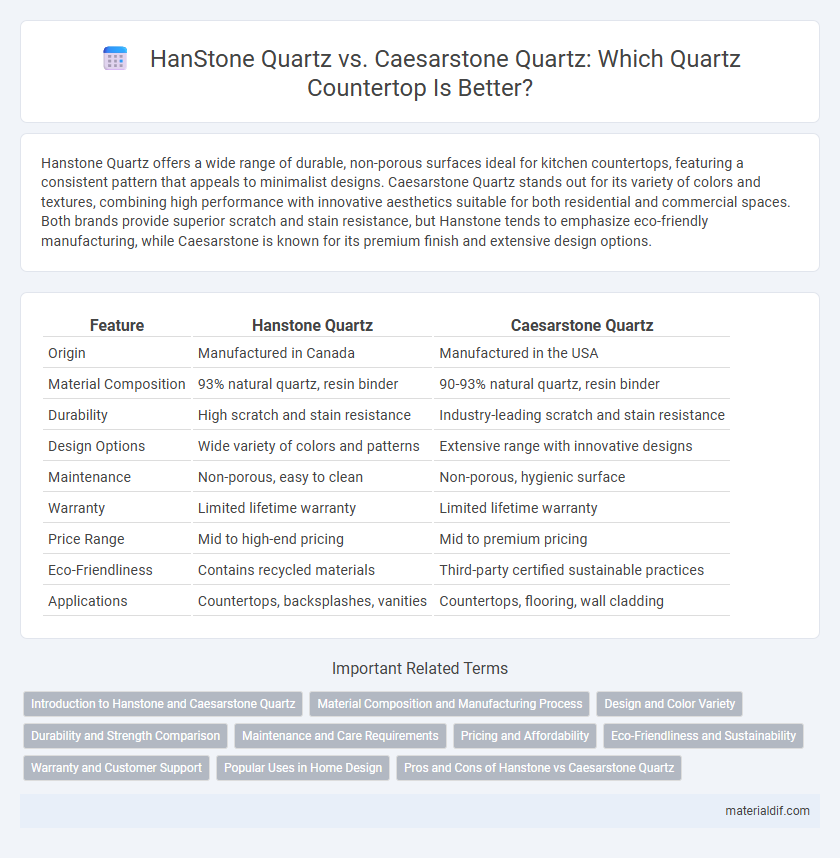Hanstone Quartz offers a wide range of durable, non-porous surfaces ideal for kitchen countertops, featuring a consistent pattern that appeals to minimalist designs. Caesarstone Quartz stands out for its variety of colors and textures, combining high performance with innovative aesthetics suitable for both residential and commercial spaces. Both brands provide superior scratch and stain resistance, but Hanstone tends to emphasize eco-friendly manufacturing, while Caesarstone is known for its premium finish and extensive design options.
Table of Comparison
| Feature | Hanstone Quartz | Caesarstone Quartz |
|---|---|---|
| Origin | Manufactured in Canada | Manufactured in the USA |
| Material Composition | 93% natural quartz, resin binder | 90-93% natural quartz, resin binder |
| Durability | High scratch and stain resistance | Industry-leading scratch and stain resistance |
| Design Options | Wide variety of colors and patterns | Extensive range with innovative designs |
| Maintenance | Non-porous, easy to clean | Non-porous, hygienic surface |
| Warranty | Limited lifetime warranty | Limited lifetime warranty |
| Price Range | Mid to high-end pricing | Mid to premium pricing |
| Eco-Friendliness | Contains recycled materials | Third-party certified sustainable practices |
| Applications | Countertops, backsplashes, vanities | Countertops, flooring, wall cladding |
Introduction to Hanstone and Caesarstone Quartz
Hanstone Quartz, manufactured by LG Hausys, is renowned for its durable, non-porous surface and a wide range of vibrant colors and patterns suited for kitchen countertops and commercial applications. Caesarstone Quartz, originating from Israel, emphasizes high-quality engineered quartz with innovative designs, combining natural quartz with resins for enhanced strength and stain resistance. Both brands offer premium quartz surfaces prized for their low maintenance, durability, and aesthetic versatility in modern interior design.
Material Composition and Manufacturing Process
Hanstone Quartz is composed of approximately 94% natural quartz with a polymer resin binder and advanced pigments, using a vibration-compaction technique in its manufacturing to create a dense, non-porous surface. Caesarstone Quartz contains about 90-93% quartz combined with polymers and proprietary pigments, manufactured through a pigmented quartz process followed by curing and polishing for durability and stain resistance. Both brands utilize engineered quartz technology but differ slightly in quartz content and proprietary manufacturing methods that impact surface hardness and aesthetic versatility.
Design and Color Variety
Hanstone Quartz offers a broad spectrum of color options, featuring over 100 unique shades that range from classic neutrals to bold and vibrant hues, catering to diverse design preferences. Caesarstone Quartz provides an extensive palette as well, with around 50 shades that emphasize natural stone aesthetics and contemporary finishes. Designers often choose Hanstone for its innovative textures and vivid color variety, while Caesarstone is favored for its elegant, timeless looks and refined surface options.
Durability and Strength Comparison
Hanstone Quartz offers exceptional durability with high resistance to scratches, stains, and heat, making it ideal for high-traffic areas and heavy use. Caesarstone Quartz is known for its superior strength and non-porous surface, preventing bacterial growth and ensuring long-lasting performance. Both brands provide robust quartz options, but Hanstone slightly excels in impact resistance, while Caesarstone is favored for its overall hardness and longevity.
Maintenance and Care Requirements
Hanstone Quartz requires minimal maintenance, needing only regular wiping with mild soap and water to preserve its non-porous surface and resist stains. Caesarstone Quartz also offers low-maintenance benefits but may require more frequent sealing to maintain its stain resistance and glossy finish. Both brands are engineered for durability, but Hanstone tends to have a slightly easier care routine, making it ideal for busy household environments.
Pricing and Affordability
Hanstone Quartz typically offers more competitive pricing compared to Caesarstone, making it a preferred choice for budget-conscious homeowners. While Caesarstone is known for its premium quality and extensive design options, Hanstone provides durable, stylish surfaces at a lower cost. Affordability of Hanstone Quartz often makes it accessible for larger projects without compromising on appearance or performance.
Eco-Friendliness and Sustainability
Hanstone Quartz incorporates 43% recycled content and utilizes eco-friendly resin, significantly reducing environmental impact compared to traditional quartz surfaces. Caesarstone Quartz emphasizes sustainability through its Green Certified products and water-saving manufacturing processes, promoting responsible resource use. Both brands demonstrate strong commitments to eco-friendliness, but Hanstone's higher recycled content offers a distinct advantage for environmentally conscious consumers.
Warranty and Customer Support
Hanstone Quartz offers a 15-year limited warranty covering manufacturing defects and provides customer support with dedicated service teams to ensure prompt assistance. Caesarstone Quartz features a 25-year limited warranty that includes coverage for structural defects and stain resistance, supported by a comprehensive customer care network with nationwide service centers. Both brands emphasize quality assurance, but Caesarstone's extended warranty period offers longer-term protection and robust customer support options.
Popular Uses in Home Design
Hanstone Quartz is favored for residential kitchen countertops and bathroom vanities due to its durable, non-porous surface that resists stains and scratches. Caesarstone Quartz is widely used in both kitchen and commercial spaces, prized for its extensive color range and texture options that complement contemporary home design. Both brands excel in creating stylish, low-maintenance surfaces ideal for high-traffic areas.
Pros and Cons of Hanstone vs Caesarstone Quartz
Hanstone Quartz offers superior scratch resistance and a wide variety of colors and patterns, making it ideal for high-traffic areas, but it tends to be pricier compared to Caesarstone. Caesarstone Quartz is known for its consistent quality and strong stain resistance, with a broader global distribution that makes it more accessible and budget-friendly. While Hanstone excels in durability and aesthetics, Caesarstone provides better cost efficiency and availability, enabling homeowners to balance performance and price.
Hanstone Quartz vs Caesarstone Quartz Infographic

 materialdif.com
materialdif.com